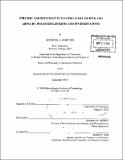Specific and efficient in vivo delivery of DNA and siRNA by polyethylenimine and its derivatives
Author(s)
Fortune, Jennifer A
DownloadFull printable version (7.994Mb)
Alternative title
Specific and efficient in vivo delivery of deoxyribonucleic acid and small interfering ribonucleic acid by polyethylenimine and its derivatives
Other Contributors
Massachusetts Institute of Technology. Dept. of Chemistry.
Advisor
Alexander M. Klibanov.
Terms of use
Metadata
Show full item recordAbstract
Linear polyethylenimine (PEI) is the "gold standard" of polycationic gene delivery vectors. However, little focus has been placed on enhancing or understanding the specificity of PEImediated gene delivery. Herein we evaluated the effect of chemical modification on the specificity of PEI-mediated nucleic acid delivery. We found that low molecular weight PEI (2 kDa) does not mediate efficient gene expression while high molecular weight (> 87 kDa) leads to toxicity. However, linear PEI of 25 kDa is an efficient gene delivery vector for both DNA and siRNA. Therefore, this PEI was chemically modified to explore the relationship between structure and specificity. First, PEI was covalently attached to a monoclonal anti-angiotensin I-converting enzyme (ACE) antibody (PEI-9B9) and evaluated for its ability to target PEI-9B9 polyplexes following intravenous delivery in a rat. Although mAb 9B9 retains affinity for its substrate ACE, PEI-9B9 does not enhance delivery to its intended target, the lung. Clearance of PEI-9B9 from circulation likely occurs before antibody binding to the surface expressed antigen. Next, we evaluated the ability of hydrophobic modification to modulate specificity of PEIbased gene delivery. Linear PEI was alkylated with variable length hydrocarbon chains at varying percent modification and evaluated for effective and specific gene delivery following intravenous delivery in mice. Modest alkylation (11% modification with ethyl chains to produce N-ethyl-PEI) enhances gene delivery in the lung 26-fold while quadrupling the ratio of gene product expressed in the lung relative to other organs. Interestingly, specificity profiles of the various alkyl chain derivatives vary among the organs examined. Additionally, a topical approach to gene delivery was investigated. Small branched PEI was cross-linked to gold to create PEI-gold nanoparticles (PEI-GNPs). These polycations were complexed with DNA and delivered topically to scratched rabbit cornea. PEI-GNPs effectively transfected corneal endothelium and evoked expression of the plasmid DNA without causing significant immunogenicity or toxicity. Finally, the effect of radiation on biologics was evaluated using a rigorously controlled experimental design with extreme conditions to unequivocally determine if radiofrequency radiation (RFR) has a non-thermal effect on biologics. Neither enzymes nor living cells (both bacterial and mammalian) were affect non-thermally by RFR.
Description
Thesis (Ph. D.)--Massachusetts Institute of Technology, Dept. of Chemistry, 2010. Vita. Cataloged from PDF version of thesis. Includes bibliographical references.
Date issued
2010Department
Massachusetts Institute of Technology. Department of ChemistryPublisher
Massachusetts Institute of Technology
Keywords
Chemistry.